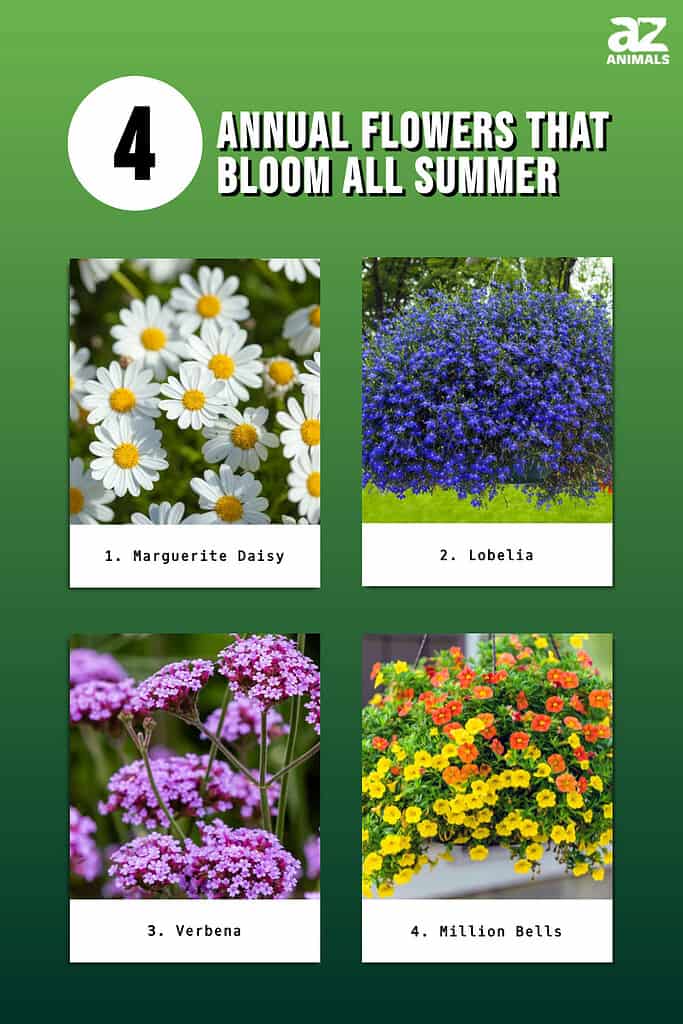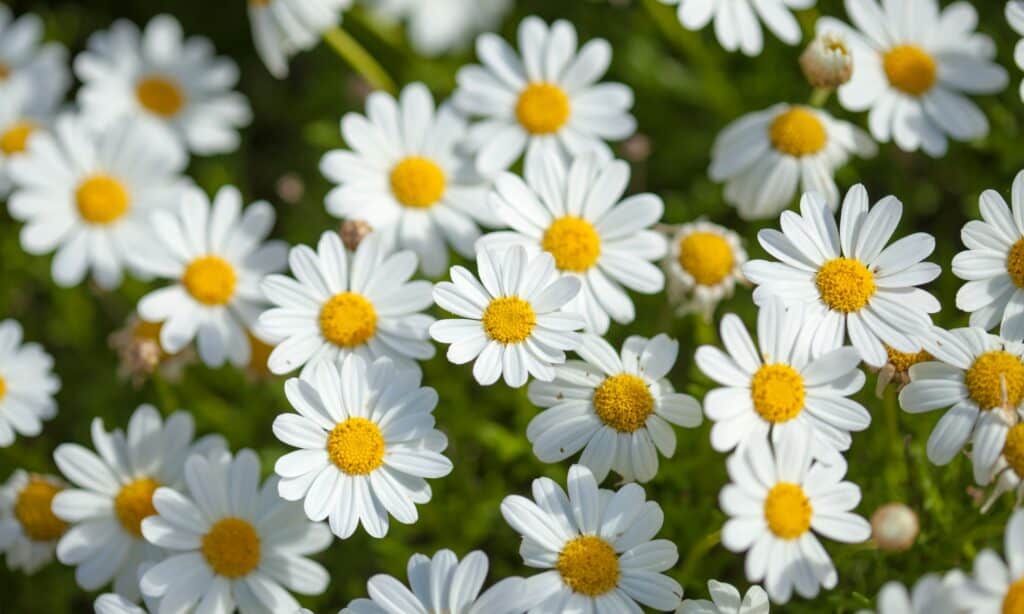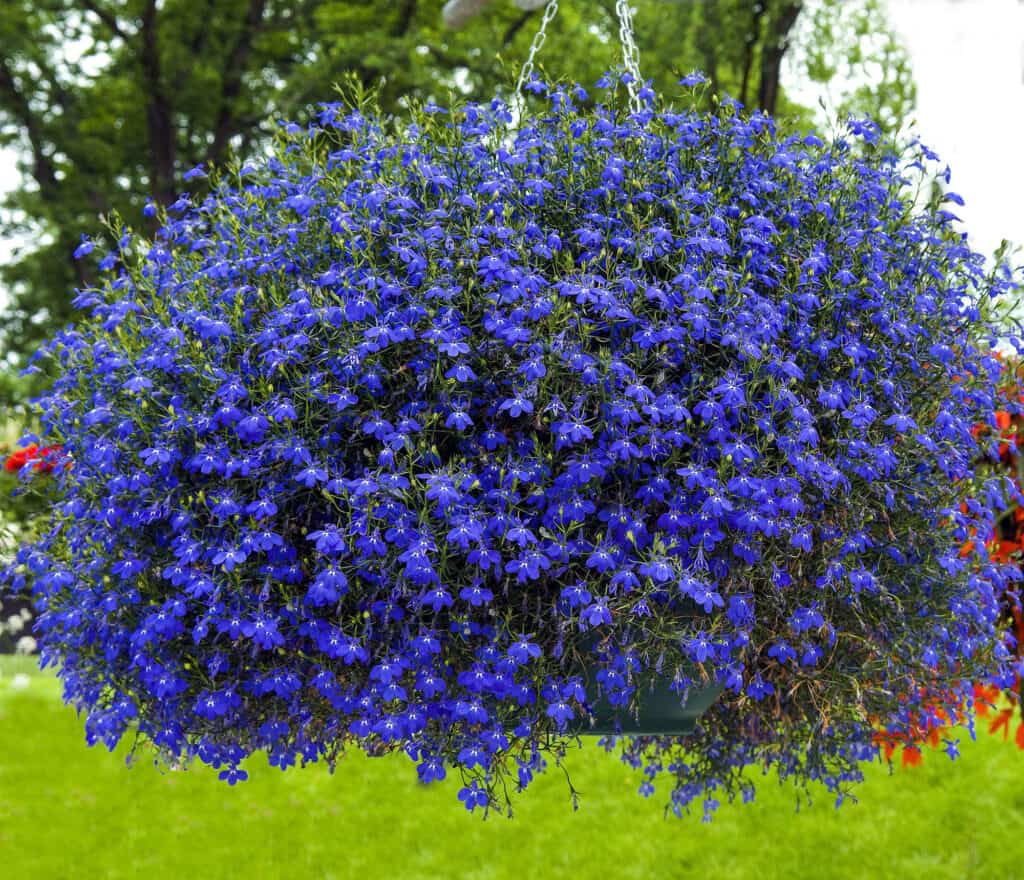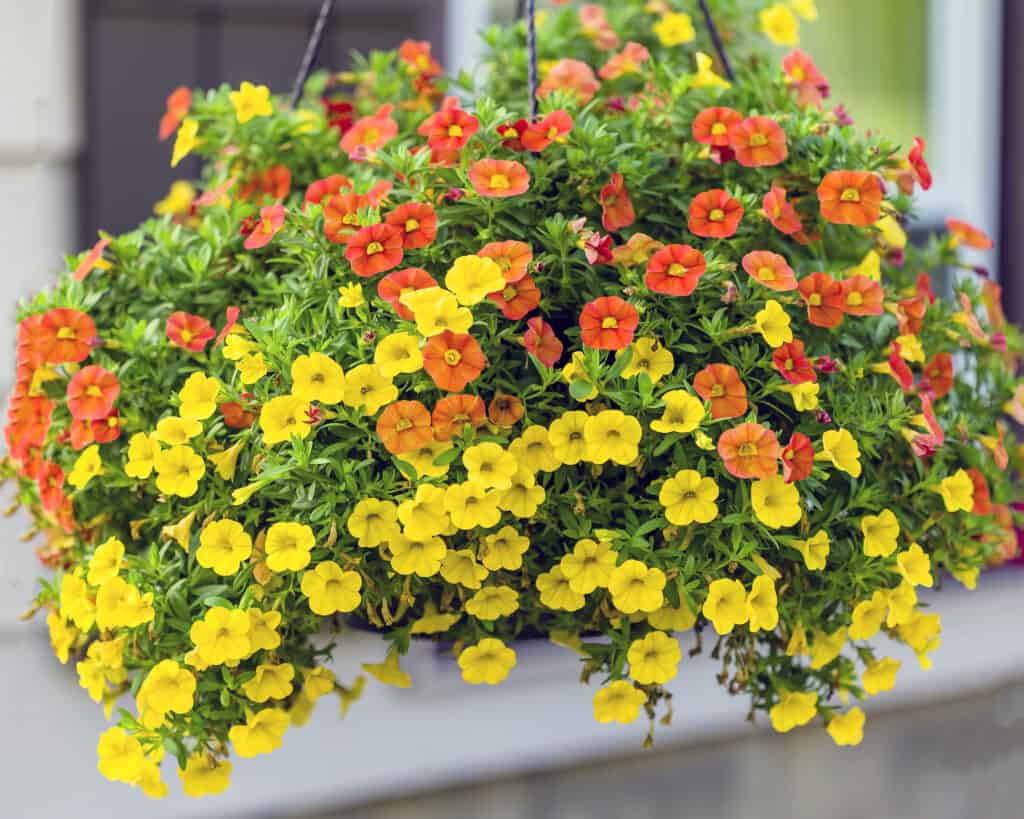
What do periwinkles look like? Imagine delicate blue, funnel-shaped flowers covering the ground.
Periwinkles are pretty to see and helpful for doctors. These annual flowers that bloom all summer help treat high blood pressure and toothaches. They’re one of the most heat-tolerant annuals, adding a splash of serenity to any yard or garden.
What other annual flowers bloom during the summer? Read on to learn about some of the best ones!
1. Marguerite Daisy

Marguerite daisy is a low-maintenance flower.
©iStock.com/tamara_kulikova
The marguerite daisy is a beautiful flower that is native to South Africa. The flower has a wide range of colors, including white, yellow, pink, and orange. This annual is a member of the Asteraceae family, including daisies, sunflowers, and chrysanthemums. The flower gets its name from its resemblance to the daisy flower. This daisy is a popular choice for gardens and bouquets due to its cheerful appearance and long blooming season.
Marguerite daisies have pretty blooms and low-maintenance care requirements. However, there are a few mistakes that novice gardeners often make when planting these cheerful flowers. One common mistake is to plant the marguerite daisy too deeply. These plants have shallow roots. You’ll want to plant them near the surface of the soil. You should also make sure to space the plants out sufficiently, as overcrowding can lead to problems with airflow and moisture levels. In addition, it’s important to choose a spot in your garden that receives full sun, as marguerite daisies will not bloom if they don’t get enough sunlight. These are one of the most exciting annual flowers that bloom all summer!
2. Lobelia

The lobelia can adapt to different climates.
©iStock.com/emer1940
Lobelia is a beautiful annual flower that is easy to grow and blooms all summer. Although it is native to South America, lobelia exists in many parts of the world. The secret to its success is its ability to adapt to different climates and soil types.
Lobelia thrives in full sun. However, it can also tolerate partial shade. It is fairly drought-tolerant and does not require a lot of fertilizer. One of the best things about lobelia is that it blooms continuously from early summer until frost. This makes it an ideal choice for gardeners who want continuous color in their gardens.
Make sure to plant your lobelia in rich, well-drained soil. This will help to prevent root rot, which can be a common problem with this plant. Second, water regularly, but be careful not to overwater, as this can lead to problems. Third, give your plants plenty of sunlight; partial shade is best. Fourth, if you live in an area with a lot of deer, you may need to take steps to protect your plants from being eaten. Something about lobelia is irresistible to hungry deer.
3. Verbena

Verbena is attractive to bees and other pollinators.
©Flower_Garden/Shutterstock.com
One of the reasons verbena is so popular is its versatility. It works as a ground cover, in hanging baskets, or as a border plant. It also comes in a wide range of colors, from deep purple to bright pink. Another reason for its popularity is that verbena is relatively low-maintenance. It tolerates heat and drought well, and it doesn’t need pruning often. Finally, verbena is attractive to bees and other pollinators. This makes it a great choice for gardeners looking to attract wildlife.
Verbena prefers full sun, so choose a spot in your garden that’s extra sunny. Since it’s a drought-tolerant plant, once it establishes, it doesn’t need a lot of water. However, during its first growing season, you’ll need to water verbena regularly to help it become established. Finally, verbena is a fast-growing plant, so you’ll need to pinch back the stems regularly to encourage bushier growth.
4. Million Bells

Calibrachoa is very easy to care for.
©iStock.com/Mark R Coons
Million bells, or calibrachoa, is a sun-loving annual that provides a profusion of color all summer long. A native of South America, million bells are in the same family as petunias. They share many of petunia’s features, including their trumpet-shaped flowers and spreading habit. However, million bells are much more heat tolerant than petunias and will continue to bloom even in the hottest summers. They are also quite drought-tolerant and can be grown without much supplemental watering once they are established. Whether planted in beds, borders, or containers, million bells add a cheerful touch of color to any garden.
Million bells are a type of petunia that is known for its colorful, trumpet-shaped flowers. These cheerful annuals are easy to care for and make an excellent addition to any garden. They prefer full sun but will tolerate partial shade. Calibrachoa should be planted in well-drained soil. Water regularly, making sure to keep the soil evenly moist. Allow the top few inches of soil to dry out before watering again.
You’ll also want to fertilize every month. Use a water-soluble fertilizer and deadhead spent flowers regularly to encourage more blooms. If you notice brown leaf spots, fungi might be attacking the plant. Environmentally friendly plant sprays targeted at the fungus will help save your flowers.
Summary of 4 Annual Flowers That Bloom All Summer
Here is a list of the 4 annual flowers that bloom all summer:
| Rank | Flower | Growing conditions | Maintenance |
|---|---|---|---|
| 1. | Marguerite Daisy | Full sun | They have shallow roots so plant them near the surface of the soil. Make sure to space the plants out sufficiently. |
| 2. | Lobelia | Partial shade/full sun | Plant in rich, well-drained soil. Be on the lookout for deer, as it’s a tasty treat for them. |
| 3. | Verbena | Full sun | In the first year, water regularly. Also, pinch back the stems regularly. |
| 4. | Million Bells | Partial shade/full sun | Fertilize every month and deadhead spent flowers to encourage more blooms. |
Up Next
Hellebore vs Lenten Rose: What Are Their Differences?
Are There Any Plants That REALLY Keep Snakes Away?
What to Plant in September: The Complete Guide
The photo featured at the top of this post is © iStock.com/emer1940
Sources
- University of Georgia, Available here: https://extension.uga.edu/publications/detail.html?number=B954
- Finger Lakes Native Plant Society , Available here: https://flnps.org/plants/naturalized-garden-interest
Thank you for reading! Have some feedback for us? Contact the AZ Animals editorial team.






